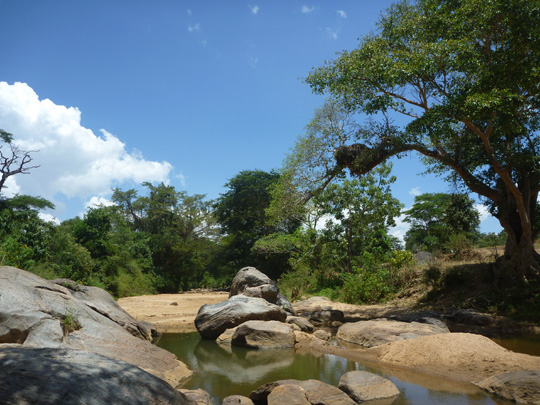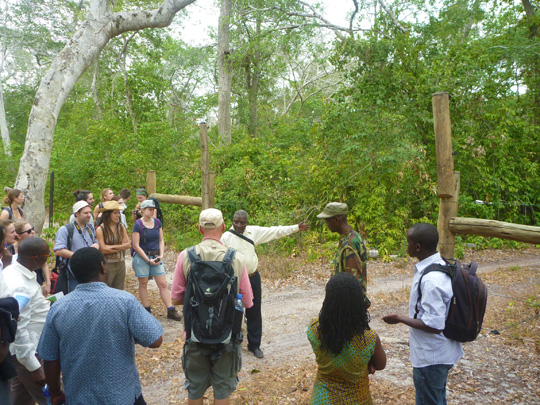Relieving Kenyan forests from stress
Freiburg, Mar 23, 2018
In recent decades large areas of forest have been cut down in Kenya. That gave the locals space for farming, wood for building and burning as fuel, as well as resources for the production of charcoal. Dr. Christine Schmitt of the Institute of Nature Conservation and Landscape Ecology at the University of Freiburg is working on solutions to better protect the environment there - while guaranteeing the local population’s interests at the same time.

Once the rivers in the Kitui savannah flowed through forests. Photo: Christine Schmitt
Arabuko-Sokoke Forest in eastern Kenya is fenced off. The locals wanted it to be. For elephants live in the coastal forest - the last largely intact one in East Africa - and they like to come out and dine on the maize and cashew crops growing nearby. For gibbons, however, who are also partial to corn and cashews, the fence presents no obstacle. “Nor does it help when the rangers who are meant to guard the forest take cash to turn a blind eye when local people go in to take wood,” says Christine Schmitt. The Freiburg plant ecologist is following the four-year project, Reconciling human livelihood needs and nature conservation, backed by the German Academic Exchange Service, the DAAD. The core issue is the conflict between locals’ interests in land use and protecting the forest in order to conserve natural environments and species.
University of Freiburg and TU Munich researchers and are working together with other German and African universities on three forest regions: the Arabuko-Sokoko Forest, the gallery forests in the Kitui savannah, and the rainforest in the Taita Hills. “All three regions are experiencing major stress, which arises primarily due to the demands placed on it by the population,” says Schmitt. The people are poor and carry out mostly subsistence farming. In the savannah of Kitui there are seasonal rivers which were once fringed by gallery forests. The population density has risen fast in recent decades, and the forest has been cleared but for a few small areas. This created space for agriculture; the wood was used for construction and as fuel, and to produce charcoal. “There is actually a Kenyan law which prohibits agriculture 30 meters left and right from a river, but because this is private land, it cannot be enforced,” Schmitt explains.
Working with the locals
Instead of bans, the researchers are trying education and cooperation. In workshops, lectures, and on-the-spot inspections they are working with local researchers, forestry authorities and environmental groups, explaining ecological interconnections, and training students. “We aim to bring the researchers together with the people on the ground, to get everyone round a table and raise awareness of environmental conservation and sustainability.” People need to understand how important trees are - for preventing erosion, and as a habitat for various species. In order to show them, Schmitt looks at the remaining forest and compiles an overview of the vegetation.

The forest in the regions investigated was cleared but for a few small areas - to obtain wood for construction, among other things. Photo: Christine Schmitt
In Kitui alone she found more than 70 native tree species - even though the forest has been decimated. She is also in contact with national research institutions which have tree nurseries - and which raise and distribute primarily exotic species. “There is a lack of experience with native species. They are often difficult to raise, so that people tend to go for exotic options like eucalyptus and Grevillea; they grow quickly and require little attention. The diversity of tree species in this region is therefore being lost bit by bit,” Schmitt says. Another big problem is the invasive shrub Lantana camara, which overgrows many areas along the rivers, driving out the native species.
Finding alternative livelihoods
But preserving the remaining trees and bushes and perhaps enabling regeneration of the areas will take more than a whole lot of informing and convincing people. “People here have a precarious existence,” Schmitt says. “If we want people to protect the environment, we have to find alternative ways for them to make a living.” The German team, together with colleagues at African partner universities, is considering just what that may look like. “Our goal is to develop concrete recommendations for action by the end of the project, so that something can be done to preserve species on the ground and which will also benefit the population,” says Schmitt. One approach will likely be to raise the proportion of native trees cultivated in the three regions under investigation.

Excursion to the fenced-off Arabuko-Sokoke Forest: Scientific collaboration with Kenyan students is an important part of the project. Photo: Christine Schmitt
“We are not an aid development project, we want to provide impetus to academic collaboration,” Schmidt stresses. So student exchanges are an important part of the project. Young Kenyans write research reports, Master’s and doctoral theses on the topic, become sensitized to environmental conflict, and can pass on their specialist knowledge. “It’s a long road; there will not be big changes overnight. But if we are able to get people thinking about the issues, we will have taken an important first step.”
So far the researchers have investigated the Kitui and the Arabuko-Sokoke Forest in the Kenyan coastal region. In 2018 the group will dedicate itself to the mountain rainforest in the Taita Hills. For the conclusion of the project in 2019 there will be a workshop at which the participants will collate their findings. Alongside the German and African researchers, non-governmental organizations and Kenyan forestry research institutions will be involved - and hopefully will go along the path towards developing species conservation in the three areas.
Claudia Füßler
Project “Reconciling human livelihood needs and nature conservation”

